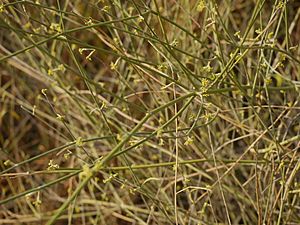Leptadenia pyrotechnica facts for kids
Quick facts for kids Leptadenia pyrotechnica |
|
|---|---|
 |
|
| Scientific classification | |
| Genus: |
Leptadenia
|
| Species: |
pyrotechnica
|
Leptadenia pyrotechnica (called खींप in Hindi and ਖਿੱਪ in Punjabi) is a special desert plant from the Apocynaceae family. You can find it growing in many dry areas, all the way from Senegal in Africa to India in Asia. This plant is super tough and can handle very dry weather, which makes it great for helping to plant trees and other plants in deserts. It is also very good at holding soil together. This means it is one of the first plants to grow and help stabilize sand dunes.
Contents
About the Khimp Plant
Leptadenia pyrotechnica is a very bushy plant. It can grow up to 3 metres (about 10 feet) tall. Its long roots can reach deep into the ground, sometimes as far as 12 metres (about 40 feet) down! The branches are green or grey-green. The leaves often fall off early. When they are there, they grow opposite each other. They are long and thin, about 2 cm (less than an inch) long and 3 mm wide.
The flowers are very small and yellowish-green. They are about 2 mm wide. They grow in small groups along the branches. Each flower has five petals and is covered in fine hairs.
The fruits are long and narrow, like pods. They can be 8–11 cm (3-4 inches) long. When they are ripe, they open up. Inside are seeds with fluffy white hairs, like those of milkweeds. The wind then carries these seeds far away.
How People Use Khimp
People use the Khimp plant in many ways.
- Building: The plant's stems are used to make roofs for huts.
- Food: The unripe fruits, called khimpoli in Hindi, can be eaten as a vegetable. They ripen around March.
- Ropes: Strong fibres from the plant are used to make ropes.
- Animal Food: Animals like camels love to eat this plant. It is considered good food for them.
Khimp in Traditional Medicine
Many different parts of the Khimp plant are used in traditional healing systems. People believe it has many helpful properties. For example, it is thought to help with:
- Fighting fungal and bacterial infections.
- Helping wounds to get better.
- Reducing harmful substances in the body.
- Lowering fats and sugar in the blood.
- Protecting the liver.
Snack Food
In Niger, shepherds often eat the raw flowers of the Khimp plant. They snack on them while looking after their animals in the dry desert areas where the plant grows.
Gallery
-
Mass of (harvested) unripe follicles





